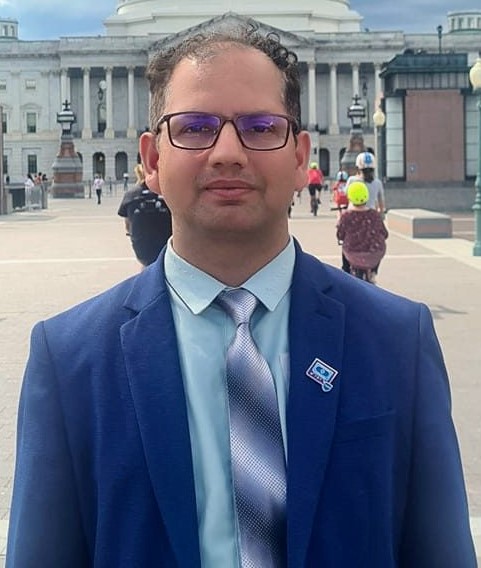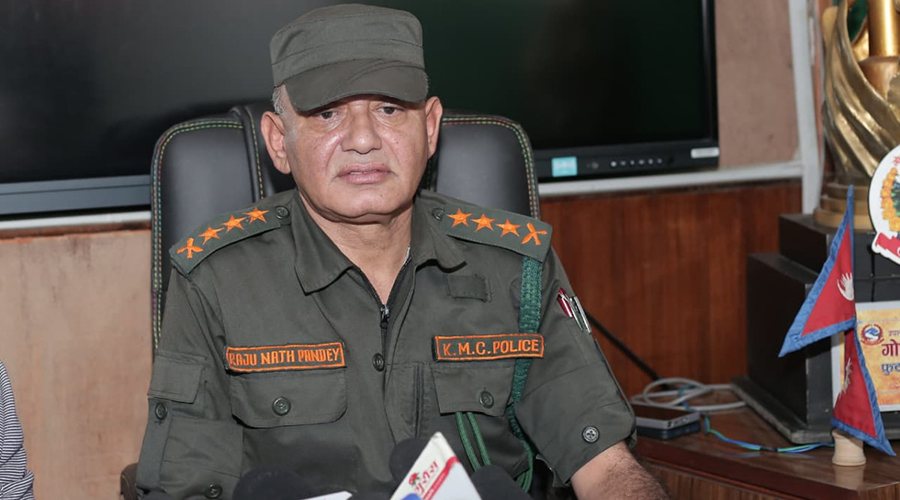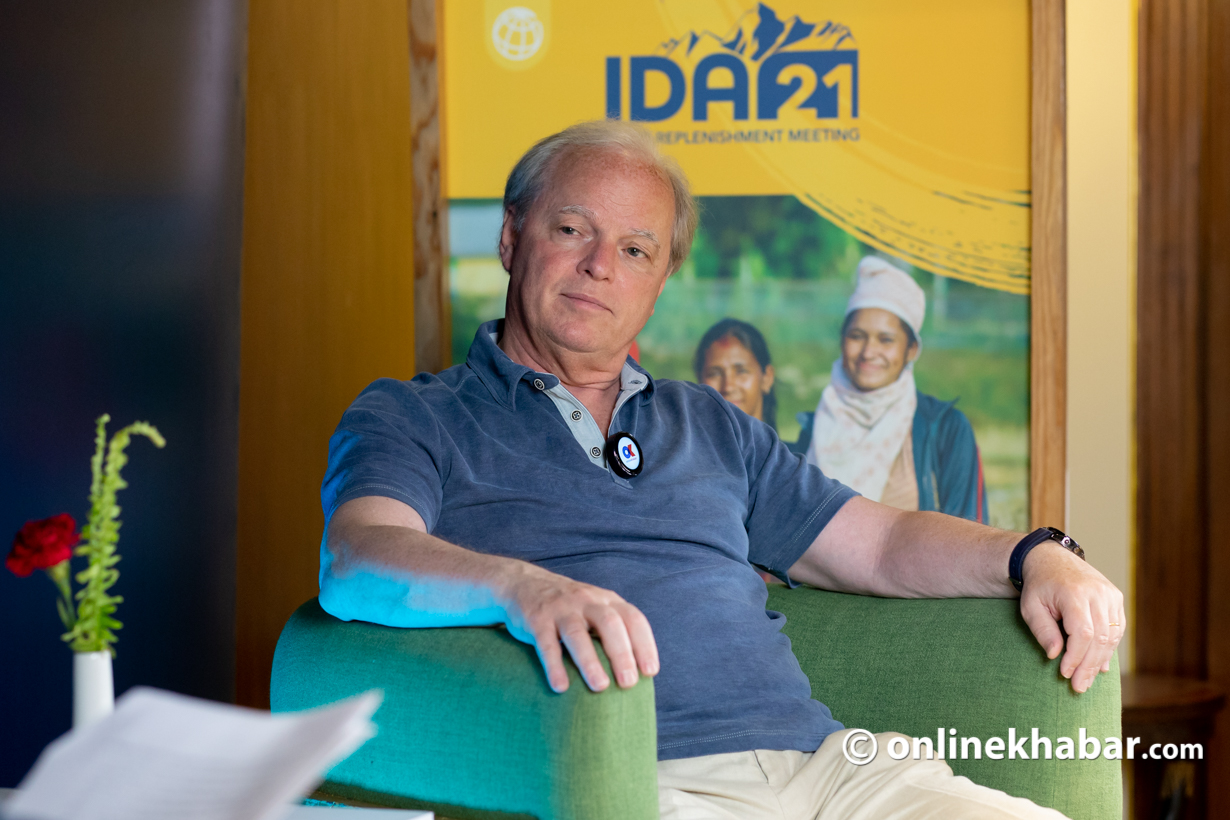
Axel Van Trotsenburg is the Senior Managing Director of the World Bank Group and is responsible for Global Development Policies and Partnerships in the organisation. A Dutch-Austrian national, Van Trotsenburg directs the World Bank’s core development work captured by the bank’s global practice groups. He co-chairs the International Development Association (IDA) replenishment and represents the bank in the G7 and G20 meetings.
Trotsenburg is also responsible for Global Development Policies and Partnerships in the organisation. Trotsenburg recently visited Nepal to chair the Third Replenishment Meeting of the World Bank’s fund for low-income countries, the International Development Association (IDA). This is the first meeting of its kind hosted in Nepal. Recently Onlinkhabar caught up with Trotsenburg.
Excerpts:
1. Currently, Nepal is hosting the Third IDA21 Replenishment Meeting. What is the purpose of this meeting, how will the IDA21 process be completed, and how can Nepal benefit from it?
Nepal is a long-term beneficiary of this fund. The World Bank has different organisations, one that provides financing on commercial terms. However, there is also a fund to provide long-term financing having interest rates below the market or even grants. For that, we need support from the international community and this fund called the International Development Association or IDA, which is being replenished every 3 years.
So we have been in existence since 1960. And, this fund has been probably the most successful in the development area. Since 1960 we have mobilised 320 billion US Dollars from donors. That’s a lot of money. With these resources, we have been able to support Nepal since 1963.
We are now in the 21st IDA replenishment negotiations. This is always a big exercise because we have about 55 donors. Then we also have the voice of our partner countries that benefit from it, including Nepal. And they bring the country’s perspective. And then the donors would like to see what kind of development priorities are being pursued. For these negotiations, it is always important that we also are at once in the country. So we negotiated intensely through about nine months.
But traditionally during the negotiation process, Zoom meetings are key. However, sometimes countries offer to host the meetings. And this time, amongst many other countries, Nepal, offered to host. So we have been extremely grateful to the government and the people of Nepal for kindly hosting us, and I think it is a big success.
2. During your visit, you met Nepal’s political leadership and high-level government officials, including the prime minister and finance minister. You also visited an IDA-funded project in Ravi Opi, Kavrepalanchowk. What did you find to be the status and challenges of Nepal’s development process?
First, it was a pleasure to meet the government because we certainly would like to thank them, personally, but also on behalf of all the attendees, for this hospitality offered to the entire group. And I think the talks have been going well.
However, it is important to bring the Nepalis perspective. During the opening ceremony, for example, we had a view over six decades of great collaboration. What is important is that we have been a strong development partner of Nepal, and we want to continue to be so.
Now you can make all the wonderful declarations of this. I think the best thing is to hear from the Nepalis themselves, what they think about the World Bank, what they think about the collaboration, and then to see the projects.
I think that by talking to the beneficiaries or seeing what people are doing, you can determine whether the projects successfully translate intentions into reality.
And, we have reserved a whole afternoon for all the attendees to visit about nine projects because not everybody can be together. So we have a whole selection, and we’ll rely on our country office and the Nepali government to see which projects we should see.
And I visited a project with colleagues that dealt with earthquake recovery. The World Bank had provided $700 million to Nepal for the earthquake recovery and reconstruction of destroyed houses.
We have been working with Nepal’s government at the time to reconstruct more than 300 thousand houses. And this time, we visited a village just to see a couple of houses, but they were representative of that effort.
We have had a meeting with the mayor of the municipality. He talked about not only the reconstruction, but the broader development challenges of the municipality; education for children, health services for all, the infrastructure, the digital challenges, the employment, and the impact of climate change.
These were some of the topics that were centre stage in the last two days of deliberations. Therefore, there you see the value of this cooperation.
I think all countries want to do better, want to do better for their populations and provide better job opportunities and digital transformation. And I think IDA can continue to accompany the country’s development path in the years ahead.
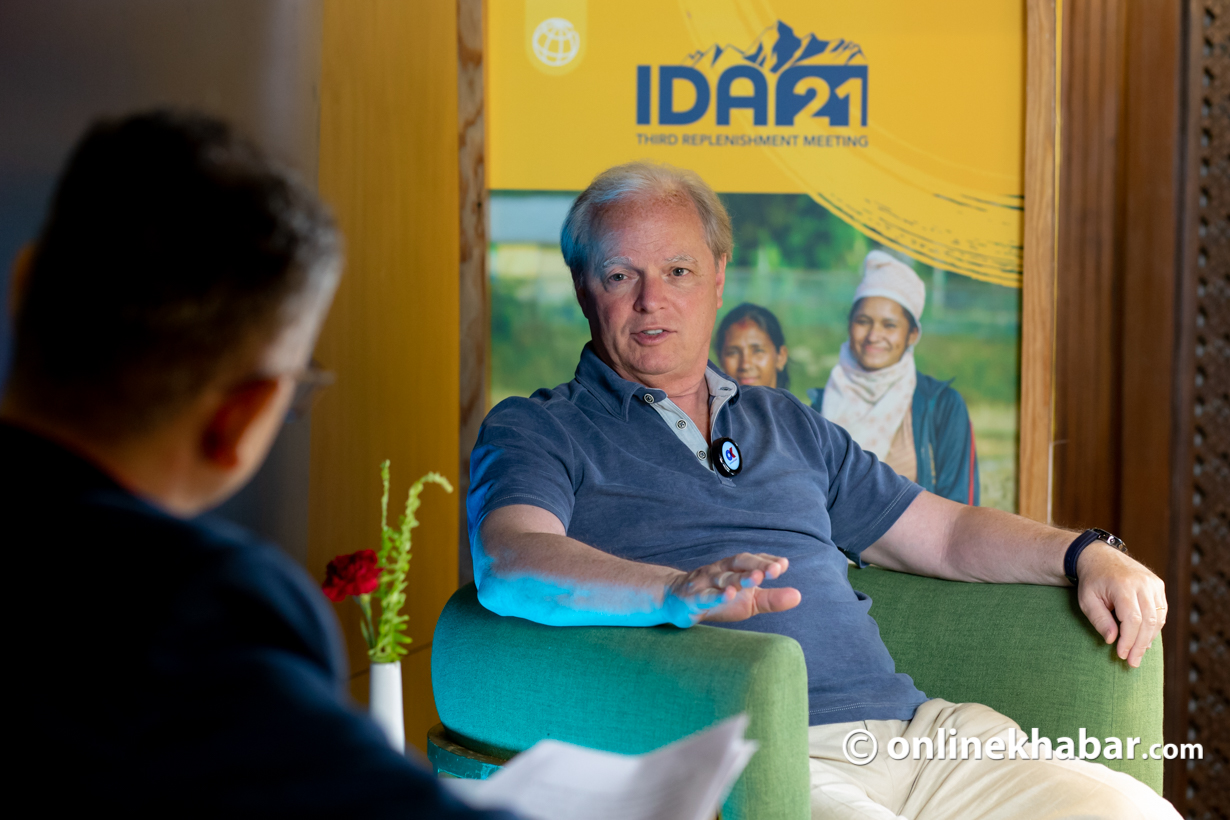
3. Similar to other poor nations, Nepal has significant weaknesses in developing human capital. The quality of education and healthcare services is poor, and the country faces brain-drain and the export of unskilled labour to the Middle East and Malaysia. What are your recommendations for Nepal to improve its human capital development system?
So the value of this meeting was also that we got a bit of a view of what has happened since the 1960s. And what we heard was that in the 1960s very few children would go to school, even fewer girls. Health services were not covered. Maternal mortality and infant mortality were very high. Malnutrition was also high.
So, most children are going to school now. But that doesn’t mean that when you go to school, you are learning. We often call this learning poverty; sometimes children go to school, but after a few years, they are still struggling to read or write. This phenomenon has been worsened as a result of Covid.
This is not a problem only in Nepal. Globally we see such problems. So we have been measuring the human capital index to see how countries are dealing with the key ingredients for human capital development and more needs to be done on this. This is a challenge. I would say it is not only a challenge for a country like Nepal.
It’s equally a challenge for many middle-income countries. Interestingly, if you look at some of the tests conducted by the OECD, even in high-income countries, effective learning remains an eternal challenge for everybody. We want to be a strong partner in improving and sharing international experiences because different countries tackle this problem in various ways. Sharing these strategies can help us find better solutions. What is most important is that the bank has always emphasised that for long-term development, you can’t get around investing in human capital.
It’s also one of the key drivers of your economic growth because an educated resource can thrive in the labour market and has many, or better prospects of earning higher sellers’ wages, and therefore that investment always pays off.
4. Nepal has one of the lowest and slowest-growing emissions in the world. A 2017 World Bank report, the Nepal Development Update, suggested that Nepal urgently needs to change its development model, as the current path is not helping it escape the low growth trap. What recommendations would you suggest for Nepal and other low-income countries to accelerate growth, break the cycle of low growth, and achieve equity?
Well, that is one of the key crises. Now while I am sitting here, I will not tell you what to eat and what you should do. I think we want to have a different approach to this. I think about many of the countries I have seen everybody wants to aspire to middle-income status and then ultimately higher income status. I think this is a good aspiration. And say, where does the country want to be in 2035 or 2040? And many countries say, well, I want to be richer, usually double or higher. It was a good idea to have such an aspiration. So let’s take that aspiration as the orientation to which you want to go.
And then maybe discuss with the interested groups in these countries what could be the main obstacles.
We completely agree that it is an important issue. But there are other issues today. For instance, things happening in digital space in the world. Many countries for the right reasons are concerned about the digital divide. This is a key concern.
So how can one narrow the digital divide and better close it? What are the policies that are required in Nepal? Or for that matter, any of the other countries, what would that be? Now in some countries, it’s a policy issue. Another one is a lack of investment.
And in another one it is taxation. There are different areas where there is money and then there is often infrastructure. Is the infrastructure helping to exploit the advantage of a country? What are the other potential export earners or big transformers?
Now I heard that here the youth and young companies have been building a lot in the digital or so that is maybe a growth rate. And also one is you have a lot of natural resources. How can one exploit electricity, and clean energies through hydroelectric and dams.
So there’s all sorts of things. We suggest an open discussion where the bank would be more than pleased with constraining effects. We have a lot of analytical work for that. The World Bank sees itself not only as a provider of financing but also as a knowledge bank. How can we provide comparative context to countries? Maybe comparative context?
5. What have countries done? What are the best practices? It depends on the country whether these things make sense in the proper national context and how one can implement them. One thing is clear: in virtually all countries, including industrialised ones, microeconomic reforms, such as those aimed at increasing competitiveness, are often necessary. These reforms can be challenging because they affect interest groups by introducing more competition. However, they are important.
And having been myself living in Latin America, some of these countries were seriously constrained by these competitive issues. And, therefore, I think one needs really to take a country context, but also never to forget the aspirations where you want to go.
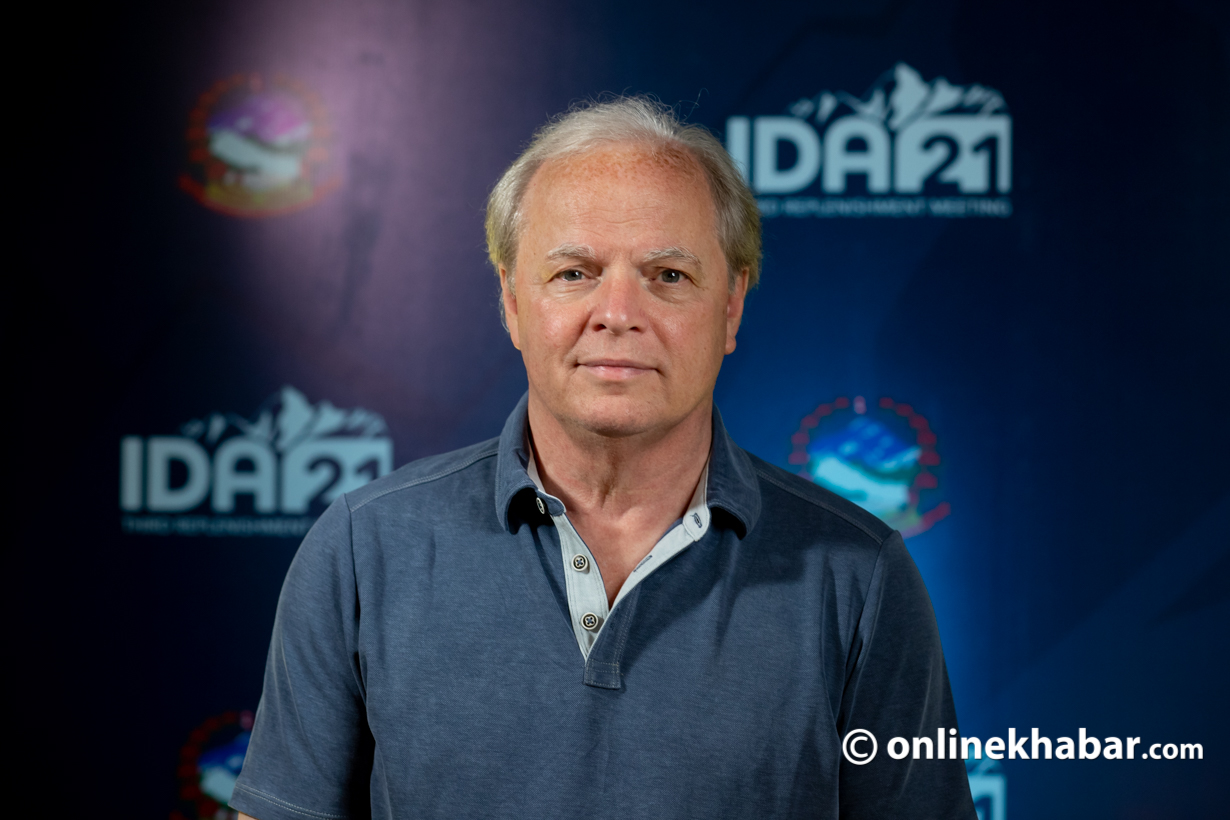
6. Despite Nepal’s negligible contribution to global carbon emissions, it is one of the countries most affected by the adverse effects of climate change. However, Nepal has not received sufficient financing for climate actions from the Green Climate Fund and other resources from the World Bank Group. What should Nepal’s future strategy be to tackle climate change and harness more resources from such global funds?
So when we’re talking about IDA, then, IDA is also the largest concessional provider of climate financing. Our fiscal year will finish at the end of June, and our estimates go that probably over 40 per cent of all our commitments are for climate change and that we may well be reaching around 13 billion USD.
So it’s not minor. And of which, also, Nepal is benefiting. I agree with you that we also need a continuous way, you know, carbon finance or climate financing. The harsh reality is that there is a shortage of this. To identify what needs to be done, one needs to see how one can benefit through other means as well.
One is selling carbon credits because in the forestry area, you have incredibly increased your forest cover and some of them can be credited because that is a global contribution. I think one needs to see also, because you have plenty of renewable capital, how one can best exploit that. So I think this is probably a combination. Can you tap into some of those resources that are concessional and can also be carbon financed and contributed? The World Bank is happy to work with you to see what other sources could be available.
But it is a challenge for many countries. Our concern is that often low-income countries have not contributed to the problem. You have been, almost a net contributor to clean air, as opposed to polluting it. But there is still a disproportionate effect of climate change, also on low-income countries that can be seen today in floods in other countries like Bangladesh.
So this is a problem that is real. And, what we will need to continue is to fight for more resources on this. And there, the bank is certainly very clear on this that we will need more support for the low-income countries in this area.
7. Many low-income countries, including Nepal, face significant gaps in infrastructure financing. However, most World Bank projects in Nepal are primarily focused on the social sector. Some projects, such as the YETI Project, have faced widespread criticism in Nepal. Could you please explain how the World Bank sets its financing priorities and selects projects?
Well, that is not so difficult. It is not like the World Bank descends on a country and tells us we are going to finance A, B, and C.
For the simple reason that it would not be sustainable. We are guests in a country. We are interested in accompanying the country in some of the areas that the government or the country sees are their priorities. So when we are looking at our financing envelope and how we can best finance, it is first and foremost that you have to listen to the country itself.
And there is a simple truth. The government or the country itself knows a little bit better than the World Bank what you would like to have. I think you need to have homegrown solutions. And then to say, based on these priorities, we can accompany you.
I think what is true is that every country can use a lot more resources. So it is also important for the government that they come to a topic on how they make hard decisions. Now, for example, in infrastructure, you have sometimes a chance to attract more private investment. And on the social side, it is more difficult.
So you have to make a trade-off. How do you want to maximize the resources that are coming into the country? It depends on the decisions of the government, but these are hard decisions because you are working with budget constraints that are quite serious
8. Lastly, what is your message to Nepal and Nepalis?
There are two messages. First, a huge thank you for hosting. This has been, I think, greatly appreciated. Judging by the participants, I believe they share this sentiment.
Secondly, the World Bank is committed as a long-term partner. We don’t just appear during crises or when the cameras are rolling; we stay long after they’re gone, offering continuous support. We look forward to many more years of constructive collaboration. Ultimately, our goal is singular: to enhance the well-being of the Nepali people.


